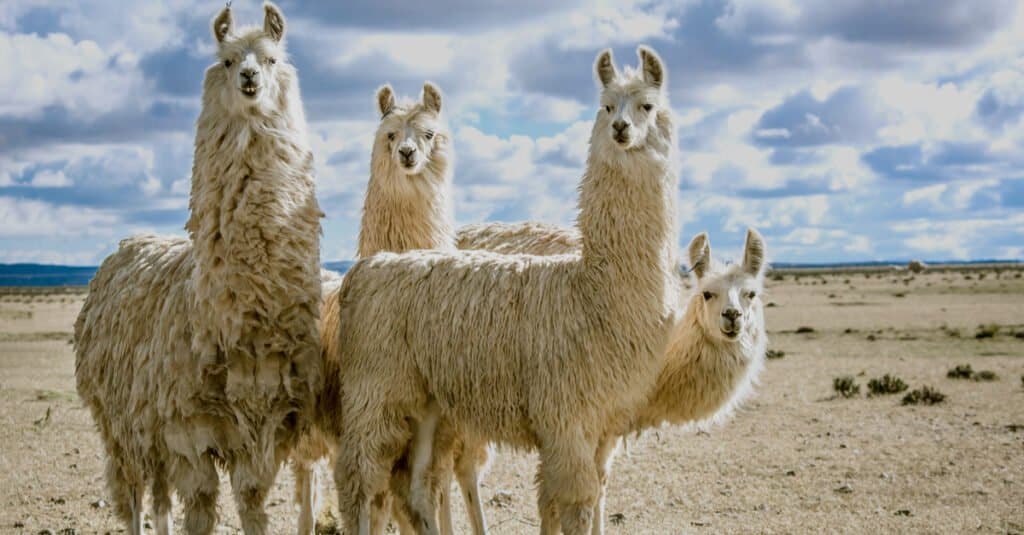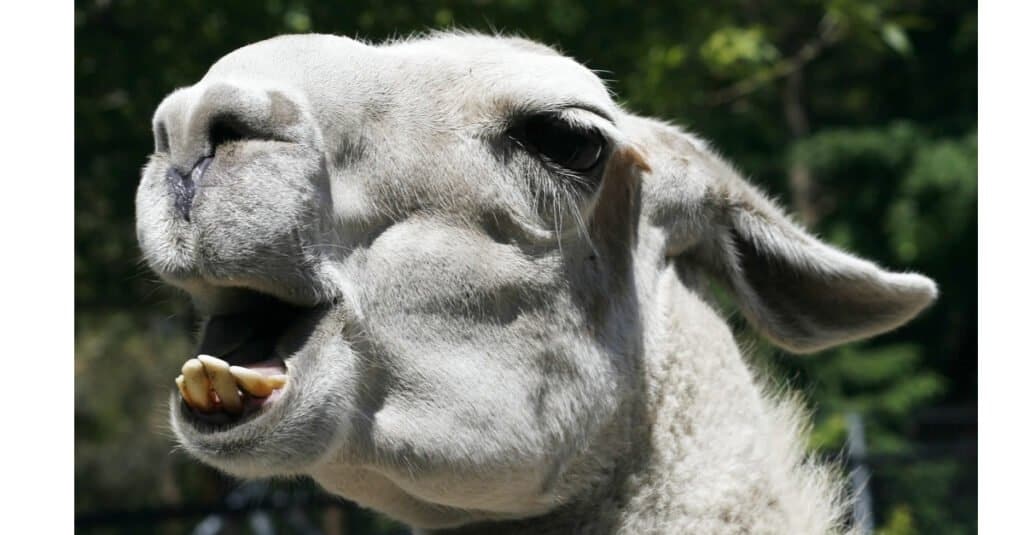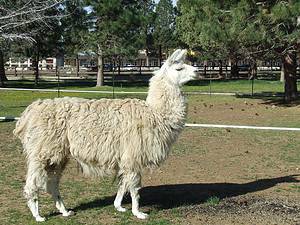Llamas (Lama glama) and alpacas (Lama pacos) are two species with a lot in common including that they have a habit of spitting. Whilst they were originally domesticated in South America, they are increasingly popular on North American farms. Both are used for wool and meat production and cart pulling as well as for guarding other livestock and even animal therapy.
These animals can make a spitting-type noise when they are sneezing because they breathe only through their nose. They often sneeze to clear out the nasal passages and this sounds a bit like a spit but it’s a completely different behavior. True llamas and alpacas ‘spitting’ is when they hurl an unpleasant substance with a lot of force out of their mouth. If you’ve ever experienced it you won’t forget it!
Do Llamas Spit to Communicate?

Llamas are herd animals and use spitting to communicate.
©Noe Besso/Shutterstock.com
Both animals are gregarious and live in groups called herds. All group-living animals need some form of communication partly to establish a hierarchy – working out who is in charge. Llamas and alpacas use spitting to do this. They can also be seen wrestling and kicking for the same reason. Spitting is used to warn others to back off and to show dominance. This can often happen when there is a dispute over food.
Do Llamas Spit When Mating?
Males may spit at each other to try to show their dominance and therefore secure a female to mate with. Also, females have been seen spitting at males to let them know that they are not interested! If the female is happy to receive the male, she will not spit at him.
Do Alpacas Spit at Predators?
Yes, llamas and alpacas use this defensive mechanism to warn off predators. It is often very effective because no animal wants to have a pile of acidic, green slime hurled into their eye!
Can Llama Spitting Be Useful?
Spitting can be a good way of judging your alpaca’s state of mind. They generally spit when they are not happy. Farmers also use this behavior to determine if a female is ready to breed – if she is not spitting at the males it means she will be receptive to mating.
Also, llamas can be used to protect herds of other domestic animals such as sheep, goats, and chickens. Once they have bonded with these animals, they see it is their responsibility to guard them from predators. Llamas have been observed scaring away foxes, coyotes, and even wolves from what they perceive to be their territory. If they see a predator approaching, they will use all of their defensive tactics to drive them away including spitting. These animals are termed ‘guard llamas’ and are most common on ranches in the western United States. Not all llamas make good guard llamas though, so it depends on the individual.
What Is Alpaca Spit Made Of?
Their spit is made up of mainly saliva, but it can have some stomach contents mixed with it. Saliva contains bicarbonates, phosphates, and urea as well as a lot of water. They may bring up undigested food and gastric juices from the first compartment of their three-part stomach. This is most likely to be chewed-up grass as this makes up the main part of their diet. It also explains why llama and alpaca spit looks green.
Is Llama Spit Toxic?
Alpaca and llama spit doesn’t smell great but it’s unlikely to do you major harm. There is nothing very toxic in llama spit but some research suggests that it can contain pathogens. For example, a disease called bovine viral diarrhea virus (BVDV) has been causing some concern in the alpaca industry over the last few decades. The pathogen that causes this disease has been isolated in both salivary glands and the gastrointestinal tract of alpacas suggesting that spitting could be one way in which it is spread between animals on farms.
Do Alpacas Like Spitting?

Llamas and alpacas do not like spitting because it makes their lips numb.
©Joy Brown/Shutterstock.com
It may surprise you to learn that alpacas don’t like spitting. It is not a particularly pleasant experience for them, and they would rather not do it. Spitting indicates that the animal is under some form of stress and they use it as a last resort. They hate the taste of their acidic stomach contents. Alpacas and llamas have even been seen looking for something tasty to take away the horrible taste from their mouths. It’s like us looking for a mint!
Does Spitting Hurt them?
Alpaca spit is acidic because it contains gastric juices from the first chamber of the stomach. As it lands on their lips, it can cause them to go numb. After an alpaca has spat, you can often see their lips hanging loosely. Their ears will be partly drawn back and you may see green stomach contents dripping from their mouth. This usually lasts for about 10 minutes and then resolves itself. However, during this time, the alpaca will find it very difficult to feed. If it is sharing a feeding bowl with other animals, they may lose out. Also, the other animals don’t like to eat feed that has alpaca spit in it. Therefore, it can upset the entire herd feeding time.
Which Alpacas Are Most Likely to Spit?
Because spitting is a defense mechanism, it is most likely to be seen in animals that feel threatened. These are often smaller alpacas and llamas who are fed up with being picked on by their larger herd mates. If you take on an alpaca that has been raised in a large herd and introduce them to your small herd, they are likely to assert their dominance by spitting.
As is the case with many creatures, some alpacas and llamas are just grumpier than others. They can get upset about the slightest thing and spit with very little provocation. It’s just a case of you finding out if your particular llama or alpaca is one of these individuals.
Some owners find that llamas that live by themselves are more likely to spit. By getting a second llama or even a companion animal like a sheep or a pony, you can often reduce the frequency of this behavior.
Are There Different Types of Llama Spitting?
Llama experts have identified several different types of llama-spitting behavior. They can spray a fine mist which often moves other llamas out of their way. At mealtimes, they can shoot whatever they happen to be chewing in the direction of another animal that is annoying them. This is simply food and saliva and does not contain any acidic stomach contents.
Finally, there is the true llama spit. This contains partly digested stomach contents and is a very unpleasant experience both for the spitter and for the recipient of the spit! It can leave both animals struggling to breathe and unable to move for several minutes.
Why Do Llamas Spit at Humans?

Llamas and alpacas spit at humans if they are stressed or uncomfortable.
©Daria_vg/Shutterstock.com
The primary reason for a llama spitting at a human is to express their unhappiness with what you are doing. Llamas often spit at humans if they are forced to carry packs that are overloaded or uncomfortable. Also, llamas who have been mistreated in the past do not trust humans and will spit out of fear. This is an important consideration when adopting a llama with an unknown history.
Having said that, you may find that a llama that you have raised yourself also spits at you. This is probably because they see you as a member of their herd and are treating you in the same way as they would treat another llama. They are simply trying to assert their dominance.
How Can You Tell if They Are About to Spit?
If you are going to spend some time with alpacas or llamas, it’s a good idea for you to be able to tell if they are about to spit at you! To be fair, they often give plenty of warning. They flatten back their ears and start to aggressively puff air from their nostrils. It’s air mixed with some saliva and makes a distinctive pffffpth sound!
At this stage, it’s a good idea for you to back off. If you don’t, they will probably tip their chin back, lower their neck and lean forward. This is a sign that a spit is imminent – if you don’t have time to get away you should at least raise your hand so that it hits you on the arm and not in your face! Llamas can spit over roughly 10-15 feet so you may struggle to get far enough away in time.
Can You Stop an Alpaca Spitting at You?
The only way you can stop an alpaca from spitting at you is to stop them from feeling threatened and defensive. If they stare at you, do not stare back because they will interpret this as a threatening posture. They know that the face is the most vulnerable part of their aggressor and will therefore aim for that. If you are used to handling these animals, you may be able to point the llama’s head upwards before the spit is ejected from their mouth. If you’re too late to do this, at least close your own eyes and mouth to make the experience a bit less unpleasant.
Sometimes, you can stop them from spitting by simply raising your hand directly in front of their face. The behavior can usually be controlled by making sure that your animal is happy and well-adjusted. A happy llama or alpaca is much less likely to spit at you.
Do Any Other Animals Spit?
Both llamas and alpacas belong to the camelid family of animals along with guanacos, vicunas, dromedary camels, and Bactrian camels. They all spit! However, this behavior is also seen in other types of animals.
As its name suggests, the spitting cobra is very good at spitting. It uses its muscles to squeeze glands in its mouth and shoot venom in the face of its attacker. The archer fish spits streams of water to knock bugs off overhanging leaves. Finally, walruses have been seen spitting mouthfuls of water at mud at the bottom of the ocean to uncover clams.
Summing up Why Llamas and Alpacas Spit at You
Llamas and alpacas spit for defensive reasons when they feel threatened, to show their dominance, and when competing for food. Males spit when competing for females and a female will spit at a male to deter his advances. They spit at humans if they are stressed or uncomfortable. It is not a nice experience for them because it contains acidic stomach contents that make their lips numb. Some llamas and alpacas spit more than others. Whilst the spit is unpleasant, it is unlikely to harm you and you can avoid getting spat at by not looking them in the eye and by moving away if they start to flatten their ears and lower their neck!
The photo featured at the top of this post is © Andrew Goodsell/Shutterstock.com
Thank you for reading! Have some feedback for us? Contact the AZ Animals editorial team.






